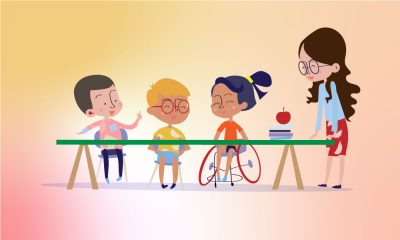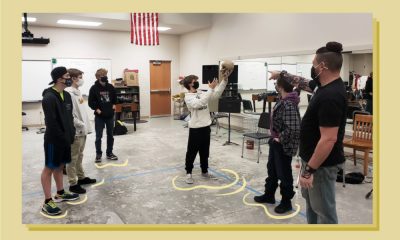Education
The Push for Financial Literacy in Schools
'Most personal conflicts arise because of money.'
Umera Raza was taken aback when her 13-year-old asked if she could remove some items from their shopping cart. Why? They’d overshot their budget and cutting back would make their lives easier. “I was overwhelmed that Zunera was aware of budget planning and smart shopping,” Umera reflected.
Zunera studies in grade 8 at Dag Hammarskjold Middle School in Wallingford, Connecticut. Her mother is grateful for the financial literacy classes at school because they have made her an “active participant in decision-making at home.” Her teacher, Gianna Gurga, has been using aids such as games and smartboard technology to provide “a hands-on experience to incorporate [financial skills] in real-life situations.”


Umera Raza was excited to see her daughter, Zunera, actively participate in making financial decisions at home. Photo courtesy: Umera Raza
Educating young people about formal financial services is crucial as it “might be able to help [them] gain control of their finances, climb out of poverty, reduce corruption, strengthen women’s workforce participation and liberalize gender norms,” Leora Klapper, a lead economist with the development research group at the World Bank, told Re:Set. When asked about what financial literacy looked like, Klapper said that according to the global financial literacy survey (which she worked on), “anyone who correctly answered three out of four questions on interest compounding, discounting and inflation [would be considered] financially literate.”


Digital teaching has been a game-changer for Gianna Gurga and her students. Photo courtesy: Gianna Gurga
Despite its efforts to introduce financial literacy into its curriculum, the state of Connecticut received an ‘F’ grade in a report card released by the Center for Financial Literacy at Champlain College in 2017 for financial literacy requirements in American high schools.
“Financial education and entrepreneurship are the two most important life skills in this day and age.”
“High schools in the state currently offer personal finance as electives or for extra credit, but they [ought to] be mandatory,” explained Christopher M. Lee, the president of Jump$tart, while speaking to Re:Set. Based in Washington D.C., Jump$tart is a not-for-profit coalition of government agencies, financial institutions and teachers, focused on creating financial literacy lesson plans for the classroom.
However, Klapper feels that classroom education alone is not enough. Instead, she emphasizes on utilizing teachable moments when people have high-stakes interactions with the financial system. “For example, a good time to teach compound interest would be while getting a credit card, or mortgage. When someone migrates, you can teach them about remittances and so on,” she told Re:Set. “At least two meta-analysis of the research [point out] that conventional approaches to building financial skills, like classroom education, don’t work.”


Pranita Zaveri received immense support from students and parents while setting up a financial literacy program. Photo courtesy: Pranti Zaveri
In Dubai, the Next Generation School (NGS) seeks to tackle this gap by adopting a simulatory approach in their kidpreneur program. “The kids are recruited for classroom jobs like stationary-keeping, and are given salaries to manage their expenses in the classroom. [They] also contribute to savings and donations with an in-school NGS currency,” Pranti Zaveri, the school’s life skills coordinator, told Re:Set. “[They] are encouraged to build on their entrepreneurship ideas and run their business.” Parents like Nashwa El Darawy have welcomed the move. “Financial education and entrepreneurship are the two most important life skills in this day and age,” she said.


Nashwa El Darawy encourages her kids to embrace financial responsibility and entrepreneurship. Photo courtesy: Nashwa El Darawy
Nonetheless, most parents are uncomfortable with discussing money matters. “Most personal conflicts arise because of money. Some parents feel it’s taboo to talk money at home or don’t have the time to discuss,” said Marilyn Pinto, who founded Kids Finance Initiative (KFI) in Dubai, in a bid to teach her daughters the value of money. The KFI team helps kids communicate openly about monetary matters and tear down these barriers. “If a session on money mindset and understanding needs and wants is held, the kids commit to share their learnings back at home. [This ensures that] parents are involved…[they are briefed] to ask questions on what the child thinks about spending money on certain items and in return the child would be able to express whether [they think it is] a genuine need. This leads to a meaningful money conversation,” Pinto cited as an example.


Marilyn Pinto started KFI in a bid to teach her daughters the value of money. Photo courtesy: Marilyn Pinto
In Nigeria, the Central Bank has reached out to multiple stakeholders in its framework for financial education programs. Their collaborators include religious institutions, schools, educational technology companies, and non-profit organizations. Promoting financial literacy is part of the bank’s larger strategy for financial inclusion. One such partnership is with Junior Achievement Nigeria (JAN), a non-profit programmatic initiative to foster financial literacy and entrepreneurship skills among youngsters.


Junior Achievement Nigeria (JAN) focuses on education programs for kids from diverse backgrounds in the country. Photo courtesy: JAN
Oduolayinka Osunloye, director of marketing and innovation at JAN, spoke to Re:Set about their activities in low-income as well as private schools across age groups. “This year we taught them [to estimate the worth of] one’s time in terms of money. This is important, [so that they] spend [their time] carefully and [are] able to ask the right money for their jobs,” he elaborated. “We also spoke about essential bank accounts one must hold, good debt, bad debt, investment and savings.”


Oduolayinka Osunloye is passionate about making Nigerian youth, especially girls aware of financial skills. Photo courtesy: Junior Achievement Nigeria
Prakash Amarasooriya is one of the people who spearheaded the financial literacy movement in Ontario, Canada. The proposal was initiated by Amarasooriya, a 27-year-old management associate at TD Trust, a Canadian banking group. To turn it into reality, he had to petition online and engage with the media, before the ministry agreed to implement it across high schools in the province this past September. “Building my financial [skills] was more out of necessity [due] to a personal crisis, than a learning opportunity. I want other students to have this opportunity,” Amarasooriya reflected.
Sia Mehta, a grade 10 student, said her class has had “one lesson [till date] where we were given a budgeting assignment and a due date. It’s quite a short unit, but it’s a subject we can all relate to. It tells us why it’s a good idea to have a financial literacy unit in the first place.”


Prakash Amarasooriya was one of the people spearheading the financial literacy movement in Ontario, Canada. Photo courtesy: Volunteer Toronto
Canada-based student group, Target Alpha, has also taken collective responsibility to promote financial literacy. “We conduct real-time events like stock pitch conferences, hackathons and provide resources to schools contributing towards financial education and technology,” Emily Lao, its 17-year-old COO, told Re:Set.
“Building my financial [skills] was more out of necessity [due] to a personal crisis.”
Projects and design-driven exercises are also used by Going to School in its curriculum designed for students of over 1,300 economically underprivileged schools across India. Its founder, Lisa Heydlauff, hopes to encourage girls to engage with the stories in this material and pick up skills to become independent entrepreneurs. “It is important to start early [to learn to] manage money, but we should not scare them with that thought. [Our curriculum aims to] connect money skills with everything around them to help them value life situations [like deciding whether to] take a loan [to study] for a job that they might never end up getting.”
Also read: We Asked 5 Teachers to Tell Us How They’re Innovating in the Classroom
The National Centre for Financial Education (NCFE), promoted by the four main financial regulators in India, is also trying to equip students through school programs and training workshops with a financial skill set. The programs are aimed at students through grades 6-10 while the workshops are targeted at young graduates. “We help youngsters become aware of various financial skills [like using digital money and evaluating financial schemes] at an early stage in their lives [to avoid falling into] debt traps in their adulthood,” said a senior member of the centre, referring to the generation’s easy access to credit cards and loans.
Studies on the importance of financial literacy show that those in the 25-36 year age bracket are particularly unaware about the subject across countries. The demographic that qualifies as financially literate typically fall into older age ranges, attributable to their lived experience in having made certain financial decisions. With a growingly complex world, the emphasis on catching them young and training them on financial decision-making has never been higher than in the 21st century.
Editor’s note: An earlier version of this story incorrectly stated the town name as Wallington. It is Wallingford, Connecticut. We regret the error.


























Sidra
December 19, 2019 at 12:19 pm
Love this. Let me know if you have similar school name in Australia?